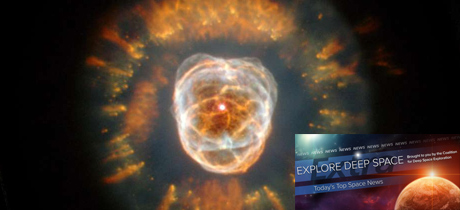In Today’s Deep Space Extra… Space Launch System (SLS) “green run” ground testing advances. U.S. ties to Russia in space could change in response to the success of NASA’s Demo-2 test flight to the International Space Station (ISS) with astronauts.
Space Policy
China amendments pose hurdle for NASA authorization
Politico (8/7): One of the last hurdles before the Senate passes a NASA authorization bill is a disagreement over a pair of amendments that would enact thorough restrictions on keeping China out of NASA programs, a Senate staffer tells us.
Human Space Exploration
Artemis testing: NASA SLS Green Run checklist
NASA Stennis Space Center (8/6): NASA is in the process of qualifying the first core stage of the Space Launch System (SLS) for its inaugural launch with an uncrewed Orion Crew Capsule in late 2021. NASA Administrator Jim Bridenstine announced on Twitter Thursday that engineers at the Stennis Space Center have now checked off item 4 on a list of eight test objectives under way this year. A full duration test firing of all first stage RS-25 rocket engines is anticipated later this year, allowing the rocket hardware to move to the Kennedy Space Center (KSC) launch site. The tweet (with test graphic) may be found here.
Space Science
Migrating big astronomy data to the cloud
Nature (8/3): Astronomy and the means by which the science discipline saves and studies what it observes is changing. Once operational in Chile in 2022, the Vera C. Rubin Observatory is to collect an estimated 20 terabytes of data each night over a 10 year Legacy Survey of Space and Time. The Square Kilometre Array, set to become a multi continent radio telescope, the world’s largest with sites in Australia and South Africa, will generate up to 2 petabytes daily when it comes on line in 2028. Too expensive to store locally, the data from these activities must be stored in data clouds that can be accessed remotely.
NASA’s OSIRIS-REx is one rehearsal away from touching asteroid Bennu
Coalition Member in the News – Lockheed Martin
NASA Goddard Space Flight Center (8/6): Next Tuesday, NASA will conduct a second dress rehearsal for the collection of sample material from the surface of the asteroid Bennu by the OSIRIS-REx spacecraft. The first rehearsal in which the spacecraft dipped close to the surface was carried out successfully on April 14. The latest rehearsal is to bring the spacecraft to an altitude of about 141 feet from the surface before backing away. The actual “Touch and Go” sample collection effort is planned for October 20. Launched in September 2016, OSIRIS-REx reached Bennu in December 2018 to begin a lengthy reconnaissance and sample site search. The spacecraft is to begin its journey back to Earth in the spring of 2021 in order to drop off the sample material on September 24, 2023 at the U.S. Army Test and Training Range in Utah.
Scientists use Moon as a mirror to study Earth during lunar eclipse
Space.com (8/6): A January 2019 observation using the Hubble Space Telescope led to an assessment of light from the Earth reflected off the Moon. The radiance revealed the presence of ozone in the Earth’s atmosphere. The study provides a template for studying the atmospheres of extrasolar planets in search of biomarkers. Ozone helps to shield life on Earth from harmful radiation and is a form of oxygen. The study was published in the Astronomical Journal.
A strange planet has been found that’s smaller than Neptune but 50% more massive
Universe Today (8/6): K2-25b is an oddball planet. It’s larger than the Earth but half the size of Neptune. However, it’s 50 percent more massive than Neptune, odd enough to call into question current theories of planet formation. In brief, it’s quite dense for its size and age, according to the study’s lead researcher from Princeton University. The findings are to be published in the Astronomical Journal.
Other News
Former astronaut & Space Foundation chairwoman Kathryn C. Thornton: 5 steps we must take to truly create an inclusive, representative and equitable society
Authority Magazine (8/5): One on One with Kathryn Thornton, chairwoman of the nonprofit Space Foundation, scientist and former NASA astronaut. “We all have a role to play in ensuring equality and justice for all our brothers and sisters,” said Thornton, a physicist and four time space shuttle crew member. “We can begin by examining our own implicit biases we all have and by acknowledging the privileges we have enjoyed.”
NASA to remove offensive nicknames for planets, galaxies and nebulae
Houston Chronicle (8/6): NASA has launched a re-examination of the unofficial nicknames used to describe distant cosmic objects. “As the scientific community works to identify and address systemic discrimination and inequality in all aspects of the field, it has become clear that certain cosmic nicknames are not only insensitive, but can be actively harmful,” NASA announced in a news release. “NASA is examining its use of unofficial terminology for cosmic objects as part of its commitment to diversity, equity, and inclusion.”
U.S. military space architecture to bring in commercial systems, small satellites
SpaceNews.com (8/5): Commercially developed technologies will be part of the future capabilities of the U.S. Space Force, Col. Russel Teehan, portfolio architect of the U.S. Space Force’s Space and Missile System Center, of Los Angeles, said in a presentation before a virtual event sponsored by SpaceNews.com. The new branch of the military’s mission is to provide “the eyes and ears” to understand what is going on in space so Space Force assets can defend them, according to Teehan. That requires advanced sensors and surveillance systems that provide what is known as “space domain awareness.”

